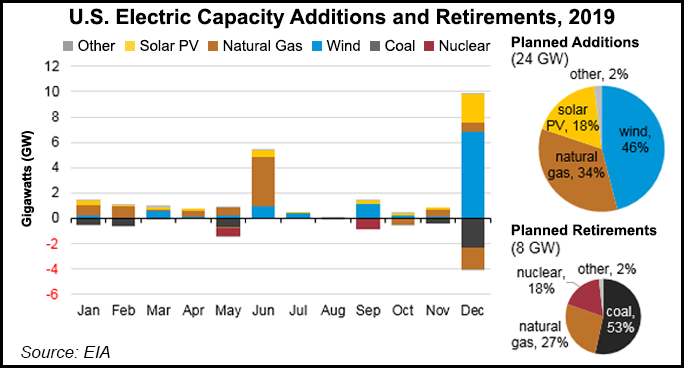Natural Gas, Wind, Again Expected to Lead Power Capacity Additions
Natural gas and renewables are again expected to account for most of the country’s power generation capacity additions this year, the Energy Information Administration (EIA) said in a note on Thursday.

The utility-scale capacity additions are expected to consist of 46% wind, 34% natural gas and 18% solar photovoltaics. The remaining 2% is expected to consist of other renewables and battery storage capacity, according to EIA’s latest inventory of electric generators.
Most of the natural gas capacity additions, or 6.1 GW, are combined-cycle plants, with another 1.4 GW of combustion-turbine plants slated to come online this year. EIA said most of the gas-fired capacity should be online by June. Sixty percent of the capacity additions are being made in Pennsylvania, Florida and Louisiana.
Rounding out the capacity additions are 10.9 GW of wind capacity, more than half of which is to be installed in Texas, Iowa and Illinois. Texas, California and North Carolina account for nearly half of the 4.3 GW of utility-scale solar power that’s planned to be added this year.
EIA said scheduled capacity retirements for 2019 consist of 53% coal, 27% natural gas and 18% nuclear. The 2.2 GW of scheduled natural gas retirements consist mostly of steam turbine plants located in California that came online in the 1950s and 1960s.
Increasingly efficient renewables and low-cost gas continue to gain ground in the nation’s power generation stack. At this time two years ago, EIA forecast 11.2 GW of gas-fired capacity additions in 2017 and 25.4 GW in 2018. The agency said at the time that if all the plants came online, annual net capacity additions would reach their highest levels since 2005.
As far as overall totals go, in 2017 natural gas and coal were close to a tie in fueling U.S. electric power, with natural gas firing 32.1% and coal 29.9%. Nuclear energy fired 20% of power, while hydropower captured 7.4% of the market, Wind 6.3%, biomass 1.6% and solar 1.3%.
© 2024 Natural Gas Intelligence. All rights reserved.
ISSN © 1532-1231 | ISSN © 2577-9877 |
